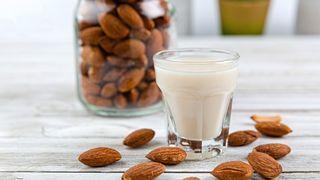Almonds: Nutrition and health benefits
Almonds offer great nutrition and are linked with a number of potential health benefits for a varied diet.

Almonds have been linked with a number of health benefits and are regularly recommended as an addition to a healthy and balanced diet by dietitians. Almonds are also the most popular nuts in the United States. A favorite of dieters, in recent years almonds have become famous for their versatility and health benefits.
According to the U.S. Department of Agriculture, Americans' demand for almonds has increased over 500% since 1980. In 2021, Americans ate an average of 2.46 pounds (1116 grams) of almonds each, an increase of about 35% from 2016.
There's good reason for the love affair. "Almonds have been studied extensively for their benefits on heart health, diabetes, and weight management," Jenny Heap, a registered dietitian with the Almond Board of California told Live Science. "The unique nutrient combination of almonds — plant-based protein, fiber and monounsaturated fats, plus key nutrients like vitamin E and magnesium — help make them a heart-healthy snack."
A 2017 study published in Nutrition Journal found that Americans, especially children, who replaced snack foods with almonds or other tree nuts saw a major increase in consumption of nutrients. In the study of more than 17,000 children and adults, participants swapped all their snacks with almonds. Researchers found that participants consumed fewer empty calories, solid fats, sodium, saturated fats, carbohydrates and added sugars. Good oils and fats increased significantly, as did magnesium, fiber and protein by a small margin.
"Regular consumption of nuts has been related to healthy effects, especially against cardiometabolic diseases. Epidemiological studies and clinical trials have reported positive effects of nuts consumption against a significant number of pathologies such as obesity, hypertension, diabetes mellitus and metabolic syndrome. In addition, individuals who consume nuts regularly present lower waist circumference and improved metabolic profiles," according to the peer-reviewed Nutrients journal.
Technically speaking, almonds are not true nuts at all. The edible part that we call a nut is actually a seed, and almonds themselves are drupes, according to the University of California Riverside's botany department. Sometimes called "stone fruits," drupes are characterized by a tough rind surrounding a shell that holds a seed. Peaches and apricots, close cousins to the almond, are common examples of drupes. Like these relatives, almonds grow on beautiful, flowering trees and thrive in warm, dry climates.
The almond tree (Prunus dulcis), also related to cherries and plums, is native to Western Asia and Southern Europe. According to the Agricultural Marketing Resource Center (AgMRC), Spanish missionaries brought almonds to the New World, but the nut's popularity did not rise until the 1900s. Today, the United States is the largest supplier of almonds in the world. California is the only state that produces almonds commercially in the United States, with 2.25 billion pounds of almonds produced in 2020, valued at $5.5 billion according to the AgMRC. California also accounts for 78% of the global supply.
How good are almonds for you?
"Ounce for ounce, almonds are higher in fiber, calcium, vitamin E, riboflavin and niacin than any other tree nut," Heap told Live Science. "Every one-ounce serving (about 23 almonds) provides 6 grams of protein and 4 grams of fiber, plus vitamin E , magnesium, riboflavin, calcium and potassium. In addition, almonds are a low-glycemic index food."
Like other nuts, almonds contain a fairly high amount of fat, with about 14 grams per one-ounce serving. Fortunately, about 80% of it is heart-healthy monounsaturated fat, according to Harvard University.
A 2005 study published in the Journal of Nutrition showed that almonds pack the biggest nutritional punch if eaten whole, with their brown skins on (unblanched), rather than with their skins steamed off (blanched). The study identified 20 powerful antioxidant flavonoids in almond skin. Combined with the high vitamin E content in the meat of the almond, these flavonoids endow almonds with a unique nutritional package that may have implications for cholesterol levels, inflammation and more.
Almond nutrition facts
Here are the nutrition facts for almonds, according to the U.S. Food and Drug Administration (FDA), which regulates food labeling through the Nutritional Labeling and Education Act:
Almonds
Serving size: 1 ounce (28 g)
Calories: 164
Health benefits

Heart
Probably almonds' best-known quality is that they are good for your heart. "Nearly two decades of research shows that almonds can help maintain a healthy heart and healthy cholesterol levels," said Heap. A 2009 article in The American Journal of Clinical Nutrition (AJCN) looked at the evidence on nut consumption and a variety of health issues. It noted that in four large-scale studies considered major in the field — the Iowa Women's Health Study (1996), the Adventist Health Study (1992), the Nurses’ Health Study (1998) and the Physicians' Health Study(2002) — nut consumption was linked to a lower risk for heart disease. Together, the studies showed an average reduction in the risk of death from heart disease by 37% , or "8.3 percent … for each weekly serving of nuts."
"A growing body of evidence suggests that regularly choosing almonds in place of snacks high in refined carbohydrates is a simple dietary strategy to help support heart health," said Heap. In another evidence review, published in 1999 in Current Atherosclerosis Reports, researchers looked at the Nurses' Health Study and estimated that eating nuts instead of an equivalent amount of carbohydrates reduced heart disease risk by 30%. Substituting nuts for saturated fats, such as those found in meat and dairy products, resulted in a 45% estimated reduced risk.
Replacing almonds with saturated fats may also help lower LDL (bad) cholesterol levels. A 1994 study published in The American Journal of Clinical Nutrition looked at men with normal cholesterol levels and found that those who supplemented their diets with almonds for three weeks saw a 10% reduction in LDL levels.
A 2017 study published in Journal of Nutrition looked at 82 people with high LDL cholesterol. For six weeks, they ate a low-cholesterol diet that included one-third of a cup of almonds or a muffin with the same number of calories. Then, participants switched diets for another six weeks. Researchers found that the almond diet led to better distribution of HDL cholesterol subtypes and more effective cholesterol removal. These effects, however, were only seen in participants at a normal weight.
"Plant sterols as found in almonds may interfere with the absorption of cholesterol and bile acid, and the high amount of unsaturated fat in almonds favors an improved lipid profile, especially when this food replaces other foods high in saturated fat and refined carbohydrate," according to Harvard University.
Many studies have linked potassium with lower blood pressure because it promotes vasodilation (widening of blood vessels), according to Today’s Dietitian. The magazine article cited a study of 12,000 adults, published in Archives of Internal Medicine, which showed that those who consumed 4,069 mg of potassium each day lowered their risk of cardiovascular disease and ischemic heart disease by 37% and 49%, respectively, compared to those who took 1,793 mg per day.
Magnesium is also essential for heart health. According to the British Medical Journal, some doctors have seen positive results from giving patients doses of magnesium to lower blood pressure and was beneficial to patients who had suffered heart failure. There also may be a link between lower heart disease risk in men and intake of magnesium.
Almonds may even be good for those suffering from hyperlipidemia (excess lipids or lipoproteins in the blood). These patients used to be instructed to stay away from nuts because of their fat content, but a study published in 2002 in the journal Circulation showed that hyperlipidemic patients who ate almonds as snacks actually saw significant reductions in heart disease risk factors.
Weight loss and preventing weight gain
"With their combination of protein, fiber, good fats and satisfying crunch, almonds are a smart snack option to help keep hunger at bay while satisfying cravings," said Heap. While she noted that "numerous studies have shown that choosing almonds as a daily snack does not lead to changes in body weight," substituting them for other snacks may help dieters. A 2003 study published in the International Journal of Obesity and Related Metabolic Disorders suggested that combining almonds with a low-calorie, high-monounsaturated fat diet led to more weight loss than did a low-calorie diet with lots of complex carbohydrates. Another recent study, published in 2015 in the Journal of the American Heart Association, looked at substituting almonds for a muffin of the same caloric value and found that though participants did not lose weight in either group, the almond-eating group saw a reduction in abdominal fat, waist circumference and fat on the legs, as well as improved LDL cholesterol levels.
Almonds can also be a more satisfying snack than high-carb counterparts. "Their combination of protein, fiber, and good fats makes them a satisfying snack choice that can help keep you from reaching for empty calorie choices between meals," said Heap. "In fact, a recent study showed that women who ate a mid-morning snack of 1-1.5 ounces of almonds felt more satisfied and ate fewer calories at subsequent meals."
As if that weren't good enough news, almonds may also help prevent weight gain. A five-year study conducted by Loma Linda University researchers and published in the European Journal of Nutrition in 2017 found that people who ate nuts, including almonds, regularly were more likely to stop gaining wait and at a 5% lower risk of becoming overweight or obese. The study evaluated more than 73,000 Europeans between the ages of 25 and 70 and found that, while most participants gained an average of 2.1 kilograms over five years, those who regularly ate nuts gained less weight. The lead researcher, Dr. Joan Sabate, suggested that people replace the animal protein on the center of their plates with nuts.
Additionally, a Spanish study published in 2007 in the journal Obesity found that over the course of 28 months, participants who ate nuts twice a week were 31% less likely to gain wait than were participants who never or rarely ate nuts.

Good for gluten-free dieters
"Almonds are naturally gluten-free, and are a versatile, nutrient-rich addition to gluten-free diets," said Heap. "Because gluten-free diets can be low in iron, fiber, B vitamins and protein, and high in saturated fat and sugar, it is important to help fill these gaps and optimize nutrition. All forms of almonds, including almond flour, almond milk and almond butter, are excellent additions for those choosing a gluten-free lifestyle."
Diabetes
According to the AJCN review of nuts and health outcomes, the links between nut consumption and diabetes risk and symptoms are less clear than with heart disease. Nevertheless, the Nurses' Health Study showed an inverse relationship between regular consumption of nuts and diabetes, as did the Shanghai Women’s Health Study (2008).
Additionally, there is some evidence that almonds can be helpful in regulating blood sugar levels. A 2006 study published in the Journal of Nutrition looked at giving participants controlled meals based either around almonds, rice, potatoes or bread. Researchers found that participants' blood sugar and insulin decreased after eating the almond meal but not the others. Also, antioxidants in the blood increased after the almond meal, while they decreased after the other meals.
Almonds may also help lower the glycemic index of a high-glycemic meal. A 2007 study, published in the journal Metabolism, looked at combining almonds and bread-based meals. The more almonds participants ate, the lower the meal's glycemic index became and the less the participants' blood sugar levels rose. Eating three ounces of almonds with the bread-based meal lowered the meal's glycemic index to less than half of that of the bread-only meal.
Energy
These tasty tree nuts can help you get moving. They are a very good source of energy-encouragers riboflavin, manganese and copper. Riboflavin is also known as vitamin B2, and it helps produce red blood cells and release energy from the carbohydrates you eat, according to the National Institutes of Health. Manganese and copper are components in an enzyme that stops free radicals in mitochondria, where our cells produce energy, according to World's Healthiest Foods. In this way, these trace minerals help maintain your body's energy flow.
Prevent gallstones
The fat and fiber content in almonds may help prevent gallstones by keeping your gallbladder and liver running smoothly. An analysis of the Nurses' Health Study in The American Journal of Clinical Nutrition showed that frequent nut consumers were 25% less likely to need a cholecystectomy, a procedure to remove the gallbladder that is often done to treat gallstones. Another study, published in 2004 in the American Journal of Epidemiolgy found similar results in men, with frequent nut consumers seeing a 30% decreased risk in gallstone disease.
Cancer
According to the AJCN nuts and health review, some studies suggest that there might be a relationship between nut consumption and reduced cancer risk in women, especially for colorectal and endometrial cancers, but these studies do not focus on almonds specifically. One animal study published in 2001 in Cancer Letters looked at whole-almond consumption in rats and found that those who ate almonds had fewer cancer cells in their colons.
"AICR’s Third Expert Report and Continuous Update Project (CUP) found evidence too limited to draw any conclusions about nuts and cancer risk. However, one analysis of large population studies identified a 15% lower overall cancer risk for each daily ounce of nuts. Studies that focus on specific types of cancer have found a reduced risk of colon, endometrial and pancreatic cancer among people who eat more nuts (usually an ounce a day), but this evidence is even more tentative," wrote Karen Collins, nutrition advisor to the American Institute for Cancer Research.
Additionally, the antioxidants and vitamin E in almonds may have cancer-fighting benefits, though the National Cancer Institute warns that results from studies examining antioxidants, vitamins and cancer are inconclusive.

Risks of eating almonds
It is possible to be allergic to almonds. An almond allergy is typically grouped with a tree nut allergy (including cashews, walnuts, Brazil nuts and others), and is usually severe.
According to the American College of Allergy, Asthma and Immunology, tree nut allergies are among the allergies most likely to cause anaphylaxis. Symptoms of an almond allergy include abdominal pain, diarrhea, difficulty swallowing, nasal congestion or a runny nose, nausea, shortness of breath, and itching. Both whole nuts and nut products, including oils and butters, can trigger an almond allergy attack.
Almonds are susceptible to aflatoxins, chemicals produced by molds that potentially can cause cancer. It is unsafe to eat almonds that are infected with mold, which appears as gray or black filaments.
In 2007, after cases of salmonella were traced to almonds, the U.S. Department of Agriculture mandated that California growers pasteurize their almonds. Since then, raw, untreated almonds grown in California have not been available. Almonds that are labeled as "raw" are actually pasteurized with steam or with propylene oxide. The practice is considered controversial, and organic farmers have sued the USDA, according to the Cornucopia Institute.
The British Dietetic Association (BDA) points out that people who regularly consume alternative milks, such as almond milk, instead of cow's milk could be at risk for iodine deficiency. While almond milk is often supplemented with calcium to make it more closely match what cow's milk provides, it is not supplemented with iodine. Iodine is essential for making thyroid hormones and for fetal brain development.
"The growth of the ‘plant-based alternatives to milk’ market in recent years has meant many consumers, and particularly vegans may be unaware of an increased risk of iodine deficiency if they do not choose well," wrote Dr Julie Abayomi, Associate Head of Applied Health & Social care at Edge Hill University.
Almonds and dogs
Animals can eat almonds safely according to the American Society for the Prevention of Cruelty to Animals (ASPCA), with some caveats. The ASPCA states that there is no evidence that sweet almonds (what is typically eaten in the United States and globally) or Brazil nuts are toxic to animals. However, the ASPCA cautions that eating large amounts can cause upset stomachs and that bitter almonds (which are not sold in the Unites States) contain cyanide and are considered toxic. Foods with high fat content, such as nuts, may produce pancreatitis. Also, many nuts are sold salted, and could pose a risk for the development of a sodium ion toxicosis.
Fun facts about almonds
- The Romans considered almonds a fertility charm and gave them to newlyweds.
- There are more than 30 varieties of almonds.
- Many almond trees are not self-pollinating and depend on bees to carry pollen to one another.
- The United States — primarily California — produces 83% of the world's almonds, followed by Australia (7%), European Union (5%), and Iran, Turkey and Tunisia (all 1%).
- Almonds should be stored in cool, dry conditions, away from direct sunlight and away from other foods with strong odors, which almonds can absorb.
Additional resources and reading
If you want to learn a bit more about almonds and their relationship to other nuts, then you should read about why almonds, pecans and peanuts aren't real nuts.
And more even more nut knowledge, find out why it is that nuts and grains go bad and how you can tell when you need to throw them out.
Bibliography
- U.S. Department of Agriculture
- Almond Board of California
- "Replacing American snacks with tree nuts increases consumption of key nutrients among US children and adults: results of an NHANES modeling study" Nutrition Journal
- "Almonds (Prunus Dulcis Mill. D. A. Webb): A Source of Nutrients and Health-Promoting Compounds" Nutrients
- "Legumes, Nuts & Seeds" University of California Riverside
- Agricultural Marketing Resource Center
- "The Nutrition Source: Almonds" Harvard University
- "Flavonoids from Almond Skins Are Bioavailable and Act Synergistically with Vitamins C and E to Enhance Hamster and Human LDL Resistance to Oxidation" Journal of Nutrition
- U.S. Food and Drug Administration
- "Nuts and health outcomes: new epidemiologic evidence" The American Journal of Clinical Nutrition
- "Dietary antioxidant vitamins and death from coronary heart disease in postmenopausal women" Iowa Women's Health Study
- "A possible protective effect of nut consumption on risk of coronary heart disease. The Adventist Health Study" Adventist Health Study
- "Frequent nut consumption and risk of coronary heart disease in women: prospective cohort study" Nurses’ Health Study
- "Nut consumption and decreased risk of sudden cardiac death in the Physicians' Health Study" Physicians' Health Study
- "Nut consumption and risk of coronary heart disease: a review of epidemiologic evidence" Current Atherosclerosis Reports
- "Partial replacement of saturated fatty acids with almonds or walnuts lowers total plasma cholesterol and low-density-lipoprotein cholesterol" The American Journal of Clinical Nutrition
- "An advantage of adding almonds to your diet?" Harvard University
- "Increasing Dietary Potassium — Find Out Why Most People Need to Consume More of This Mineral" Today’s Dietitian
- "Sodium and Potassium Intake and Mortality Among US Adults" Archives of Internal Medicine
- "Magnesium for the prevention and treatment of cardiovascular disease" British Medical Journal
- "Dose response of almonds on coronary heart disease risk factors: blood lipids, oxidized low-density lipoproteins, lipoprotein(a), homocysteine, and pulmonary nitric oxide: a randomized, controlled, crossover trial" Circulation
- "Almonds vs complex carbohydrates in a weight reduction program" International Journal of Obesity and Related Metabolic Disorders
- "Effects of Daily Almond Consumption on Cardiometabolic Risk and Abdominal Adiposity in Healthy Adults With Elevated LDL‐Cholesterol: A Randomized Controlled Trial" Journal of the American Heart Association
- "Eating nuts can reduce weight gain, study says" Loma Linda University
- "Nut consumption and weight gain in a Mediterranean cohort: The SUN study" Obesity
- "Legume and soy food intake and the incidence of type 2 diabetes in the Shanghai Women's Health Study" The American Journal of Clinical Nutrition
- "Almonds Decrease Postprandial Glycemia, Insulinemia, and Oxidative Damage in Healthy Individuals" Journal of Nutrition
- "Riboflavin" National Institutes of Health
- "Frequent nut consumption and decreased risk of cholecystectomy in women" The American Journal of Clinical Nutrition
- "A Prospective Cohort Study of Nut Consumption and the Risk of Gallstone Disease in Men" American Journal of Epidemiolgy
- "Whole almonds and almond fractions reduce aberrant crypt foci in a rat model of colon carcinogenesis" Cancer Letters
- "Nuts for Cancer Prevention: Health Benefits and Hype" by Karen Collins American Institute for Cancer Research
- "Antioxidants and Cancer Prevention" National Cancer Institute
- "Tree Nut" American College of Allergy, Asthma and Immunology
- Cornucopia Institute
- "Iodine: The debate around fortification" British Dietetic Association
- "Internet Myths and Rumors: Pet Toxin Edition" American Society for the Prevention of Cruelty to Animals
Sign up for the Live Science daily newsletter now
Get the world’s most fascinating discoveries delivered straight to your inbox.
Jessie Szalay is a contributing writer to FSR Magazine. Prior to writing for Live Science, she was an editor at Living Social. She holds an MFA in nonfiction writing from George Mason University and a bachelor's degree in sociology from Kenyon College.













